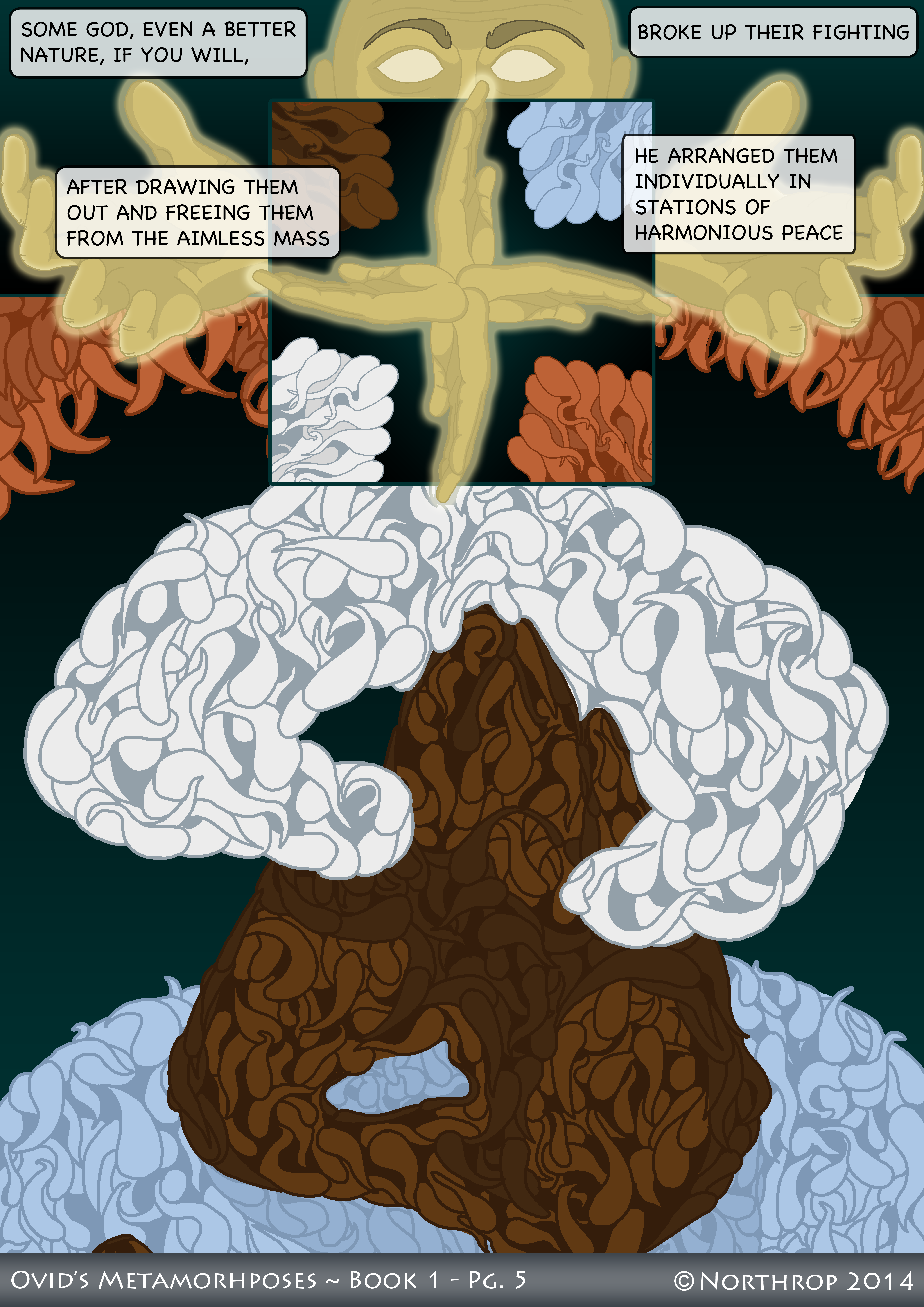Met. 1.21-25 – The Creator Appears
HANC DEUS ET MELIOR LITEM NATURA DIREMIT.
NAM CAELO TERRAS ET TERRIS ADSCIDIT UNDAS
ET LIQUIDUM SPISSO SECREVIT AB AERE CAELUM;
QUAE POSTQUAM EVOLUIT CAECOQUE EXEMIT ACERVO,
DISSOCIATA LOCIS CONCORDI PACE LIGAVIT.
THIS STRIFE A GOD, EVEN A BETTER NATURE, RESOLVED.
FOR HE DREW THE LANDS FROM HEAVEN, AND WATERS FROM THE LANDS
AND SEPARATED THE LIQUID HEAVEN FROM THE DENSE AIR;
WHICH THEN HE DREW OUT AND PLUCKED FROM THE BLIND MASS,
AND, DIFFERENT IN THEIR PLACES, HE BOUND THEM WITH A HARMONIUS PEACE.
Thus we see our first glimpse of the mysterious creator god (often referred to as the demiurge). Ovid says little about his creator, but I think the enigma adds to his appeal. Being nameless, and faceless, we can project any identity we want on him! As far as his appearance goes, I decided to make him as generic as possible: his skin is gold, so that he doesn’t conform to any particular race; his head is bald; his face is largely obscured. Since he is a creator, I tried to emphasise his hands over his other features. Because of this, I can certainly say I got a lot of practice in drawing them (they say hands are the hardest part of the body to draw… and they’re right…)
The elements begin to take their positions here, and also their properties: the lands and the waters are opposed; the air is denser than heaven. Here “heaven” actually refers to the “aether”, a firey layer at the top of the Greco-Roman cosmos. If you go out on clear day and look up at the sky, you may see a thin whiteness around the top of your vision. That whiteness is evidence of the aether. It is the lightest, thinnest element of all. The proof that fire is the element of the aether is evident in its movement: heat rises, and fire wants to fly up and take its rightful place in heaven.
This movement is motivated by a force that ancient philosophers called “necessity”. Necessity essentially makes all elements act in the “right” way, taking their correct stations and having the correct properties. This is perhaps the sense of “melior natura” (“better nature”). This line of the poem is quite strange, but in fact represents the first instance of a common feature of the Metamorphoses: alternative versions. Ovid didn’t invent much for this poem, but he did judiciously select, edit and modify material. He did this to make mythological history function as a cohesive whole for the story he wanted to tell; this is what he means in the introduction when he calls his poem “unbroken”. However, at times he expresses his own confusion about the story and gives alternate versions to remind his reader that the narrative past is not so clearly decipherable. Yet, it is these alternative versions, he seems to say, that make the mythic tradition so colourful; even these must be preserved when we remember the stories of the past. Here he recognises that, while some believe a creator god organised the cosmos, it could even be simple “necessity” as the philosophers have it. You are invited to see the “deus” as a sentient being, or a raw force of nature. Likewise, I invite you to see my depiction of the creator as either the eyes and hands I draw, or an allegory for nature herself. Ambiguity is, after all, a necessary aspect of literature. The choice, in the end, is yours, oh reader…

The Ovid is the first story I’ve read where the God or force remains nameless. The temptation for an author to name things must be overwhelming.
Nice job on the hands btw.